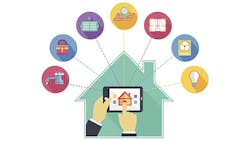GE Bringing Good Things—And the Internet of Things—To Life
A few weeks ago I had the opportunity to attend the 2014 GE User Summit in Orlando, Fla. It was a worthwhile event with some significant takeaways. (For the record: It was not, as some in my office have suggested, a boondoggle so I could go scuba diving and get a little too close to an eight-foot sandbar shark.)
GE, the company founded by the legendary Thomas Edison, is embarking on an interesting business strategy. If you haven’t noticed, they’ve sold off or are selling all their consumer divisions. That’s extremely noteworthy as GE has a 100-year history of consumer product development. They invented the electric fan in 1902. They invented the electric toaster, the electric range, the self-cleaning oven, and the hermetically sealed home refrigerator. I could go on, but the list is too long to repeat here. The consumer business has been very important to GE over the last hundred years.
And now it’s gone. They’ve sold their entire appliance business to Electrolux in Sweden. That follows divesture of plastic, insurance, and media businesses, among others. They’re still in finance, but the only consumer business left is the light-bulb business and I’m betting that doesn’t last much longer.
The highlight of the conference for me was a presentation by CEO Jeff Immelt, who was handpicked by the legendary Jack Welch in 2000 to succeed him. The presentation answered the question “Where is GE going?” The short answer is “Industrial Automation” and specifically the Internet of Things (IoT), or, as they call it, the Industrial Internet.
GE, led by Mr. Immelt, believes that the world is changing. One of his key points was that hardware is now irrelevant. If your company isn’t a software company today, it will be one tomorrow. Hardware is cheap, commoditized, and largely irrelevant. Everything of importance that you will deliver to customers in the future is a product of your software efforts and, more specifically, what data you collect and how you scrutinize that data to deliver actionable information to your customers. (As an aside, this is not much different than what I heard in August at Microsoft, only they are leveraging their Azure product.)
GE believes they have a massive opportunity to take a leadership role in a new paradigm in all sorts of manufacturing industries. The new paradigm looks like this:
SMART MACHINING + ENABLING TECHNOLOGY + ANALYTICS = EXCEPTIONAL RESULTS
What that equation means is that if you equip machines with smart sensors, you securely collect that data someplace where it can be processed using advanced analytic software you can deliver exceptional results. Results like a 1% decrease in fossil fuel usage. That may not seem like a lot, but for things like aircraft engines and locomotives, it’s a massive amount of money for their customers (and GE).
They detailed at the conference how a single GE engine on a flight from Orlando to Chicago now generates 2 terabytes of data. Delta Air Lines uses that kind of data to vastly improve the in-service time of their fleet. In fact, they’ve used GE’s analysis software, Proficy Vision, to decrease the number of planes out of service from an average of 35 to around 15 or so. That’s an almost 60% decrease in out-of-service airplanes, meaning they can afford to reduce the number of planes in their fleet by one or two. I haven’t checked the Amazon price for a 737 or an MD88 lately (you can buy anything on Amazon), but I would bet reducing your fleet by a few airplanes is a massive reduction in capital equipment that generates a huge boost to a balance sheet.
GE is going after results like this in several markets like Transportation (aviation, rail), Medical (Healthcare delivery), and Energy (oil and gas). They have the expertise to equip machinery and systems with sensors, the technology to move the data securely from remote locations, the advanced analytic engine (Proficy), and teams of smart people with domain-specific knowledge who can identify action plans from that information that generate exceptional outcomes.
This file type includes high resolution graphics and schematics when applicable.
Changing the Paradigm
So what does that mean for all of us who don’t build aircraft engines and train locomotives? A lot of us develop less glamorous industrial equipment like scales, valves, inductive sensors, and drives. Others are designing processes, building machines, or just keeping the machines humming so that the shelves are filled at Walmart.
Well, I have good news and bad news.
The good news is that a lot of what we do isn’t going to change all that much or all that quickly. There will still be logic controllers and they’ll still control automation devices with traditional networks like EtherNet/IP, Profinet IO, Profibus DP, DeviceNet, and all the rest.
For now anyway.
The Germans are working really hard at completely changing that paradigm. It’s an effort they call Industry 4.0. That effort is aimed at eliminating all the grunt work it takes to connect a machine to another machine. Today, if you have some kind of production machine--for facial tissue, for example--and you buy somebody’s packaging machine for that tissue machine, there is a lot of work to interface the two machines. Industry 4.0’s goal is to make that process automatic. Hook them up electrically, hook them up mechanically, and the two machines will talk to each other and figure out how to work together to package tissues.
That sounds pretty far-fetched, but I saw a very early demonstration in Germany earlier this year. They had a four-section machine and could hook the components up in any order and the machines would figure things out and start making parts. It was very impressive. The German government, the German automation industry (including Siemens), and their top universities are all working to make that more seamless and automatic. I wouldn’t bet against them.
The bad news is that a lot of other stuff beyond the central logic core of our automation systems is changing. Where there used to be a wall between the enterprise and the factory floor won’t even be an invisible line in the future. You won’t be able to design an automation system without considering how you’ll deliver data to enterprise systems. Most factory-floor devices will have dual personalities. They’ll be traditional automation devices on one side and IT devices on the other. Initially they’ll do that with one Ethernet connection, but two Ethernet Phys with two different TCP/IP addresses will be common.
On the IT network they’ll use things like Web Services and OPC UA to directly pass data to local cloud servers and system monitors. You’ll use all that data with advanced analytic software to increase quality and operating efficiencies, plan maintenance, and design new machines. If you were a factory-floor guy in the past, you are going to be an IT guy in the future.
A key to all this is OPC UA.
OPC UA is the next generation of OPC technology. UA is a more secure, open, reliable mechanism for transferring information between servers and clients. It provides more open transports, better security, and a more complete information model than traditional OPC, which I will refer to as OPC Classic. UA provides a very flexible and adaptable mechanism for moving data between enterprise-type systems and the kinds of controls, monitoring devices, and sensors that interact with real-world data.
Why a totally new communication architecture? OPC Classic is limited and not well-suited for today’s requirements to move data between enterprise/Internet systems and the systems that control real processes that generate and monitor live data. These limitations include:
·Platform dependence on Microsoft – OPC Classic is built around DCOM (Distribution COM) an older communication technology that is being de-emphasized by Microsoft
·Insufficient Data Models – OPC Classic lacks the ability to adequately represent the kinds of data, information and relationships between data items and systems that are important in todays connected world
·Inadequate Security – Microsoft and DCOM are perceived by many users to lack the kind of security needed in a connected world with sophisticated threats from viruses and malware.
UA is the first communication technology built specifically to live in that “no-man’s land” where data must traverse firewalls, specialized platforms and security barriers to arrive at a place where that data can be turned into information. UA is designed to connect databases, analytic tools, Enterprise Resource Planning (ERP) systems and other enterprise systems with real-world data from low-end controllers, sensors, actuators and monitoring devices that interact with real processes that control and generate real-world data.
UA uses scalable platforms, multiple security models, multiple transport layers and a sophisticated information model to allow the smallest dedicated controller to freely interact with complex, high-end server applications. UA can communicate anything from simple downtime status to massive amounts of highly complex plant-wide information.
For more information, you can read the paper I wrote on UA in the technologies forum of www.rtaautomation.com or you can click on the Contact Us link at the top of the home page and request a free copy of my OPC UA book.
John S. Rinaldi is president of Real Time Automation, which provides industrial networking technology to system integrators, machine builders and product designers in a variety of industries. He is author of four books, including two technology books; Industrial Ethernet and OPC UA: The Basics: An OPC UA Overview For Those Who May Not Have a Degree in Embedded Programming. There are a limited number of free copies for Machine Design Readers. To request a free copy, visit the “ Contact Us” link at http://www.rtaautomation.com/.
About the Author
John Rinaldi
Chief Strategist, Business Development Manager, and CEO
As Rinaldi explains it, he escaped from Marquette University with a degree (cum laude) in Electrical Engineering to work in various jobs in the automation industry before once again fleeing back into the comfortable halls of academia. At the University of Connecticut he once again talked his way into a degree, this time in Computer Science (MS CS). He achieved marginal success as a control engineer, a software developer, and an IT manager before founding Real Time Automation, "because long-term employment prospects are somewhat bleak for loose cannons," he says.
With a strong desire to avoid work, responsibility, and decision making (again, as he explains it) Rinaldi had to build a great team at Real Time Automation. And he did. RTA now supplies network converters for industrial and building automation applications all over the world. With a focus on simplicity, U.S. support, fast service, expert consulting and tailoring for specific customer applications, RTA has become a leading supplier of gateways worldwide. Rinaldi admits that the success of RTA is solely attributed to the incredible staff that like working for an odd, quirky company with a single focus: Create solutions so simple to use, the hardest part of their integration is opening the box.
Rinaldi is a recognized expert in industrial networks and the author of three books: The Industrial Ethernet Book, OPC UA: The Basics (an overview of the enhancements to OPC technology that allow for Enterprise communication), and a book on women and relationships — as he puts it, proof that insight into a subject is not necessarily a prerequisite for writing about it.


